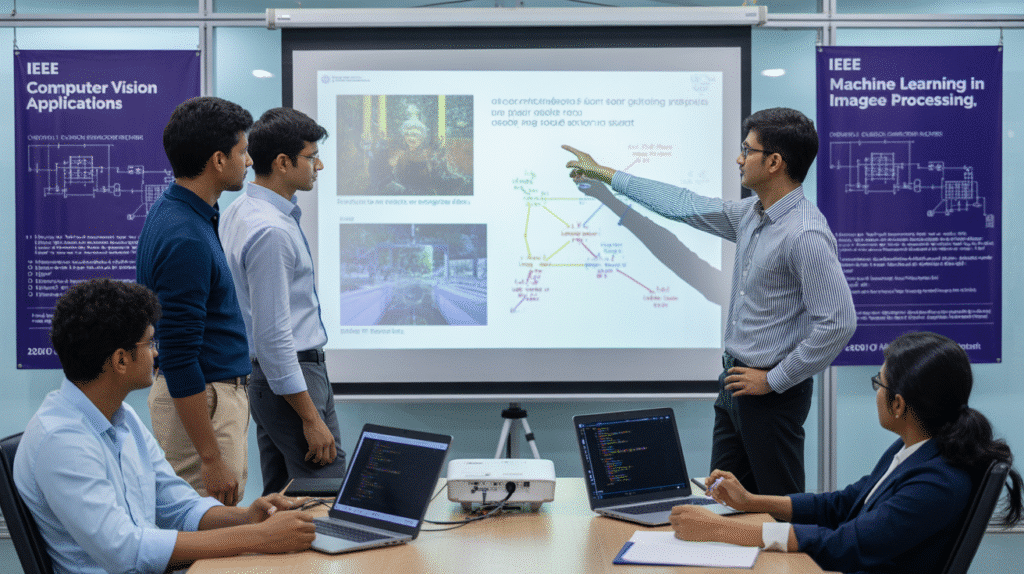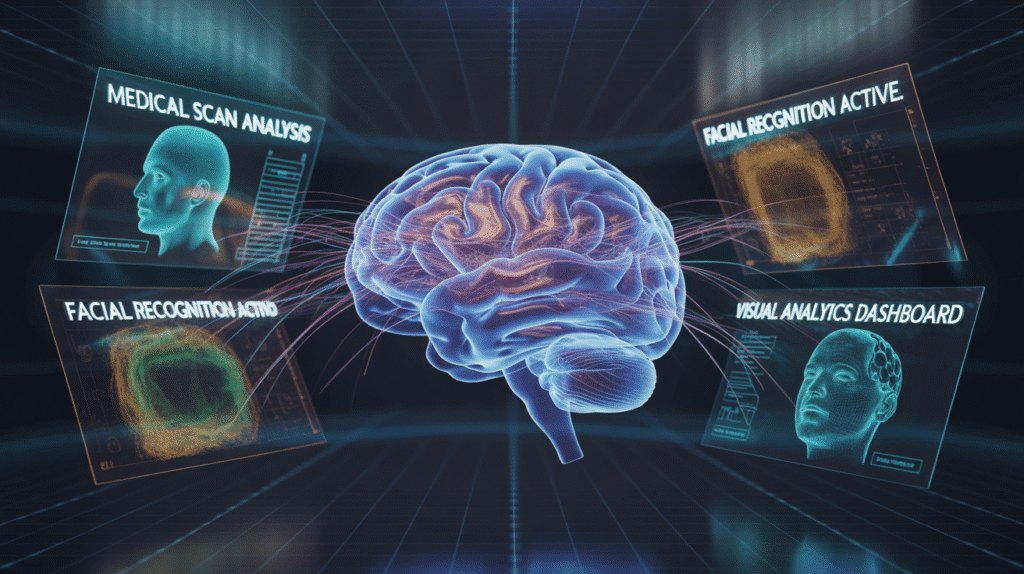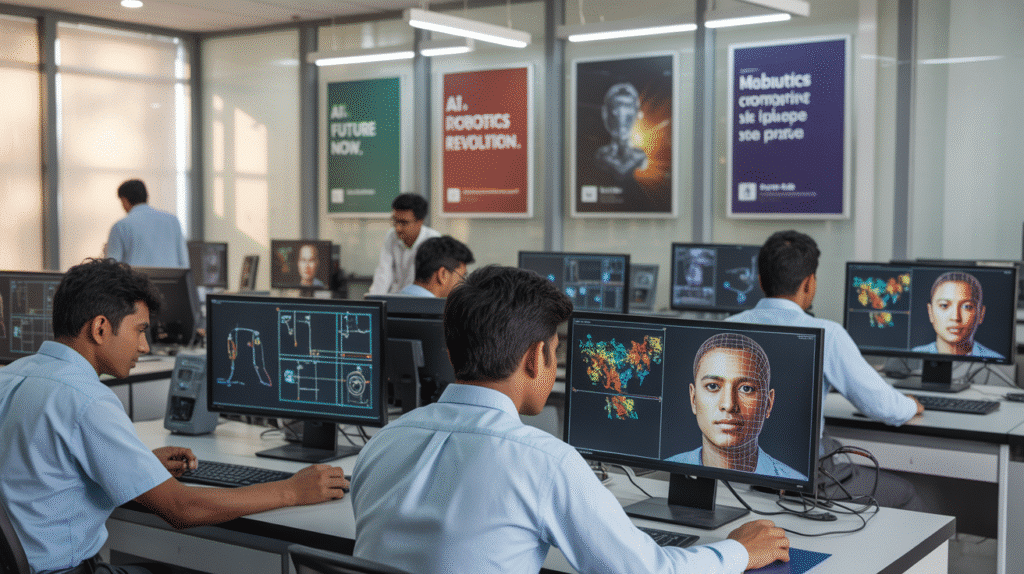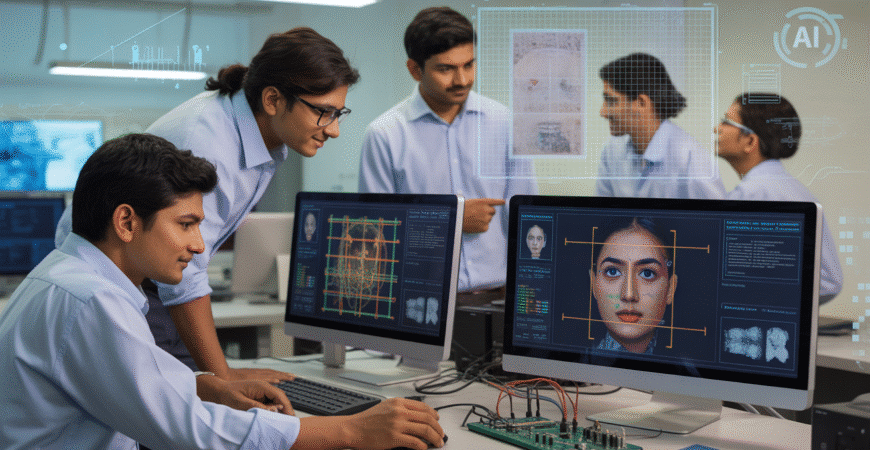Why Your Next Digital Image Processing Project Matters
The ability of machines to “see” and interpret the world is the cornerstone of modern technology, driving advancements in healthcare, automation, and security. This capability is made possible by Digital Image Processing (DIP). At its core, DIP involves manipulating digital images using sophisticated algorithms to either improve image quality (enhancement) or extract meaningful information (analysis).
The scope of Digital Image Processing is incredibly wide. It forms the backbone of critical applications, from enhancing subtle details in medical imaging (like X-rays or MRIs) to ensuring security through smart surveillance and powering the next generation of AI-driven recognition systems.
Given this immense impact, the demand for high-quality Digital Image Processing Projects for Final Year Students is surging. For students in Computer Science, Electronics and Communication Engineering (ECE), and Electrical and Electronics Engineering (EEE), mastering a Digital Image Processing project is a non-negotiable step toward a successful career. It’s the ultimate showcase of algorithmic thinking and practical application.
To bridge the gap between theory and industry-ready solutions, ClickMyProject is the top destination. We offer a curated catalog of Digital Image Processing Project Ideas, backed by hands-on guidance, IEEE-based concepts, and complete documentation, ensuring students transition smoothly from learners to innovators.
Getting to Know Digital Image Processing in Detail
What exactly is Digital Image Processing? Simply put, it’s the use of computer algorithms to perform operations on a digital image. This is fundamentally different from traditional, analog image enhancement methods (like darkroom techniques) because DIP operates directly on the binary data of the image (pixels).
The process generally occurs in three key stages: image acquisition (capturing the image and converting it into digital data), processing (applying algorithms), and output interpretation (displaying the improved image or extracting features).
Core techniques in any Digital Image Processing project include:
- Filtering: Removing noise or enhancing edges to improve clarity.
- Segmentation: Partitioning an image into multiple segments to locate objects or boundaries (e.g., separating a tumor from surrounding tissue).
- Compression: Reducing the data size for efficient storage and transmission.
- Feature Extraction: Identifying key patterns (like corners, lines, or textures) for recognition systems.
Many complex algorithms in this field are developed and tested using powerful simulation tools. That’s why many students opt for Digital Image Processing Projects using MATLAB. MATLAB is preferred for its robust environment, extensive toolboxes for image manipulation, and straightforward algorithm testing. ClickMyProject understands this need and provides a range of pre-tested, MATLAB-based project kits to simplify implementation for students.
The Role of Digital Image Processing Projects in Student Skill Development
Why are Digital Image Processing Projects for Final Year Students so vital? These projects are the crucible where theoretical knowledge is forged into practical expertise. They challenge students to apply concepts in linear algebra, probability, and software engineering to solve tangible visual problems.
Working on a Digital Image Processing project strengthens several core competencies:
- Algorithmic Understanding: You gain deep insight into how image algorithms work, from simple thresholding to complex Convolutional Neural Networks (CNNs).
- Coding Efficiency: Projects require optimized code to handle large image files and real-time processing, significantly boosting your programming skills.
- Real-World Application: You connect academic concepts directly to applications like diagnosing disease or controlling traffic, giving your work immediate relevance.
Furthermore, a well-executed Digital Image Processing project is often the centerpiece of final year evaluations and a strong foundation for research presentations. By tackling advanced concepts, students stand out. That’s why we focus on providing the Best Digital Image Processing Projects for Engineering Students, ensuring the academic significance matches the career prospects.

New Developments and Breakthroughs in Digital Image Processing Projects
The field of Digital Image Processing is being rapidly transformed by the power of AI, deep learning, and computer vision. These advancements are pushing image analysis far beyond simple filtering.
Key trends shaping new Digital Image Processing Project Ideas include:
- Deep Learning for Diagnostics: Using neural networks for accurate, rapid image-based disease prediction (e.g., detecting signs of diabetic retinopathy from retinal scans).
- Advanced Recognition: Sophisticated systems for real-time facial recognition and emotion detection in surveillance and human-computer interaction.
- Remote Sensing: Applying machine learning to satellite image classification for urban planning, environmental monitoring, and disaster management.
- Hardware Integration: Increased integration with VLSI (Very Large Scale Integration) and IoT for faster image computation, enabling real-time edge processing and automation in smart devices.
Students must work on topics that align with this future. Latest Digital Image Processing Project Ideas 2025 are those that incorporate these cutting-edge elements. ClickMyProject is committed to innovation, regularly updating its project library with the latest concepts, aligning with IEEE standards and current academic trends to keep students ahead of the curve.
Ready-to-Implement Digital Image Processing Projects for Final Year Students
Choosing the right project determines your specialization. These highly relevant Digital Image Processing Project Ideas 2025 offer a great mix of challenge and market value.
A. MATLAB-Based Digital Image Processing Projects
These projects are excellent for demonstrating strong algorithmic comprehension.
- Image Noise Reduction using MATLAB Filters: Implementing and comparing advanced filtering techniques (e.g., Wiener, wavelet) to optimize image clarity.
- Object Recognition System using Deep Learning: Using MATLAB’s deep learning toolbox to build a system that identifies specific objects within a dataset.
- Skin Cancer Detection through Image Segmentation: Developing an algorithm to segment and classify suspicious moles or lesions in dermatoscopic images.
- Satellite Image Analysis for Land Monitoring: Utilizing image processing techniques to analyze aerial photos for changes in vegetation or water bodies. This uses Digital Image Processing Projects using MATLAB for simulation.
B. VLSI-Based Digital Image Processing Projects
Ideal for ECE/EEE students, these projects focus on hardware optimization. These are crucial Digital Image Processing Project Ideas 2025 for hardware careers.
- High-Speed Edge Detection System using FPGA: Implementing Canny or Sobel edge detection algorithms directly onto a Field-Programmable Gate Array (FPGA) for real-time performance.
- Real-Time Image Compression using VLSI: Designing a hardware circuit for efficient image compression (e.g., using Discrete Cosine Transform) for faster transmission.
- Hardware-Accelerated Image Denoising Circuit: Creating a specialized VLSI circuit to perform filtering operations with low latency.
- Smart Image Reconstruction for Medical Applications: Developing a hardware module to quickly reconstruct complex 3D medical images from planar data. These are specialized Digital Image Processing Projects using VLSI.
C. AI and Machine Learning Integrated Projects
These projects leverage computational intelligence for smart vision systems.
- Image Classification using CNN (Convolutional Neural Networks): Building a CNN model to classify large image datasets (e.g., distinguishing between different types of animals or vehicles).
- Emotion Detection from Facial Expressions: Developing an AI system to analyze video frames and categorize human emotions (anger, joy, sadness).
- Smart Surveillance System using AI Vision: Creating a system that uses image processing to detect abnormal activity (e.g., intrusion or unattended baggage) in video streams.
- Hand Gesture Recognition for Robotic Control: Using computer vision techniques to translate real-time hand movements into commands for a robotic arm.
D. Real-Time and IoT-Based Digital Image Processing Projects
These projects focus on immediate, context-aware processing.
- IoT-Based Traffic Monitoring System: A system that uses an image sensor and cloud connectivity to analyze traffic density and report congestion in real-time.
- Real-Time Vehicle License Plate Recognition: Developing an algorithm that accurately segments and recognizes characters from moving vehicle plates.
- Smart Agriculture Monitoring using Image Sensors: Analyzing aerial or ground-level images to assess crop health, detect pests, or manage irrigation needs.
- Intelligent Waste Detection System: A system that uses image processing on a conveyor belt to automatically sort or identify different types of waste.
How to Choose the Right Digital Image Processing Project
Selecting the best Digital Image Processing Project for Final Year Students is a strategic decision that affects your specialization.
- Identify Your Specialization Focus:
- ECE/EEE: Lean toward hardware-centric projects like Digital Image Processing Projects using VLSI or real-time IoT integration.
- CSE/IT: Focus on algorithm implementation, AI/ML integration, and application development, often using Python or MATLAB.
- Evaluate Tool Familiarity: Choose projects that utilize tools you are comfortable with or willing to master quickly, such as MATLAB for mathematical analysis or FPGA for hardware.
- Assess Complexity and Resources: A good project is challenging but feasible within your timeframe. Consider the required hardware (cameras, sensors, FPGA boards) and data resources.
- Application Relevance: Pick a topic with a compelling real-world application, be it healthcare, security, or automotive, to make your project stand out.
ClickMyProject simplifies this process by providing customized project suggestions, targeted training support, and all necessary documentation for easy and successful implementation.
Top Reasons to Do Your Digital Image Processing Project with ClickMyProject
We ensure your Digital Image Processing Project becomes your most valuable professional asset.
- Access to a Vast Repository: Explore hundreds of high-quality Digital Image Processing Projects built using MATLAB, VLSI, Python, and OpenCV.
- End-to-End Support: From topic selection to final presentation, ClickMyProject offers personalized guidance and mentorship.
- Live Demos and Technical Assistance: Every project comes with working video demos, drastically reducing coding errors and boosting conceptual understanding.
- Comprehensive Project Packages: Receive complete documentation, well-commented source code, and detailed technical explanations for seamless academic submission.
- Support for All Academic Levels: Whether it’s simple mini projects or advanced research models, ClickMyProject has suitable Digital Image Processing Projects for Engineering Students.

Advanced Platforms and Techniques in Digital Image Processing Projects
Successfully executing a Digital Image Processing Project relies on mastering the right tools.
- MATLAB: As mentioned, MATLAB is the go-to tool for rapid prototyping, complex mathematical modeling, and initial algorithm testing in Digital Image Processing. Its intuitive environment is excellent for signal and image analysis.
- OpenCV and Python: OpenCV (Open Source Computer Vision Library) coupled with Python is essential for real-time applications, machine learning integration, and creating final deployment systems due to its speed and versatility.
- VLSI Hardware (FPGA/ASIC): For high-speed, parallel processing required in real-time video surveillance or medical imaging, VLSI hardware like FPGAs is used. Combining VLSI with image processing enhances processing speed and power efficiency, which is vital for embedded systems.
Next-Generation Project Focus: AI and Multimodal Vision
Future Digital Image Processing projects are deeply integrated with sophisticated computational models:
- Foundation Models and Multimodal AI: The next wave of Digital Image Processing projects will utilize multimodal AI, which combines visual data (images/video) with text and other data types. This allows systems to not only identify objects but also to understand context, generate natural language descriptions, and make complex decisions. Projects can focus on automatically generating detailed product descriptions from images or creating advanced image tagging systems that understand semantic relationships.
- Generative AI 2.0: Moving beyond simple image creation, generative AI in a Digital Image Processing project will be used for enterprise-grade tasks. This includes synthetic data generation for training models in rare scenarios (e.g., generating rare medical conditions or dangerous industrial defects) and creating new visual content with built-in governance and retrieval capabilities.
- Explainable AI (XAI): As models become more complex, a critical Digital Image Processing project will focus on Explainable AI. These projects aim to develop robust algorithms that can justify their outputs, which is vital for building trust and ensuring accountability in high-stakes fields like medical diagnostics and autonomous driving.
Real-World Impact: Edge Computing and Specialized Applications
The application landscape for a Digital Image Processing project is expanding into real-time, high-impact areas:
- Edge-Cloud Synergy: The trend is shifting toward running intensive processing on Edge Computing devices (like smart cameras or local processors) while utilizing the Cloud for centralized data storage and complex model retraining. A sophisticated Digital Image Processing project could implement this edge-to-cloud architecture to achieve millisecond response times in applications like factory quality control or real-time traffic management.
- Privacy-First Vision: Growing privacy concerns necessitate a new class of Digital Image Processing project. These projects focus on anonymization tools (like blurring faces/license plates), synthetic data generation (to train models without using real, private images), and building systems that are compliant with regulations like GDPR.
- Neuromorphic and Quantum Imaging: Looking further ahead, research-level Digital Image Processing projects may explore Neuromorphic Imaging (which mimics the human brain’s visual processing for high-speed, low-power vision) or Quantum Imaging (which uses quantum mechanics to achieve superior sensitivity and resolution in low-light or complex medical scenarios).
ClickMyProject recognizes that learning is optimized through flexibility. We offer both purely simulation-based projects (e.g., using MATLAB) and hardware-implementation versions (e.g., using FPGA) to cater to different learning styles and academic needs.
Future Scope of Digital Image Processing Projects
The future of Digital Image Processing is boundless, driving innovation across nearly every sector. It is central to the development of:
- AI Healthcare Diagnostics: New startups are constantly emerging based on DIP and AI to provide instant, remote medical assessments.
- Autonomous Systems: Self-driving cars and delivery drones rely entirely on real-time image processing for navigation and object avoidance.
- Advanced Security: Next-generation security systems will use multimodal image and video analysis for threat detection and behavioral prediction.
Students who develop Best Digital Image Processing Projects for Engineering Students in these domains are positioning themselves for unparalleled career growth. ClickMyProject ensures your preparation is future-proof, continuously updating our Digital Image Processing Project Ideas 2025 yearly to align with these cutting-edge technological advancements and the demands of the modern job market.
Career Trajectories Fueled by a Digital Image Processing Project
Students who successfully develop the Best Digital Image Processing Projects for Engineering Students in these domains are positioning themselves for unparalleled career growth. A strong Digital Image Processing project on your resume opens doors to roles like Computer Vision Engineer, AI Developer, and Robotics Specialist. ClickMyProject ensures your preparation is future-proof, continuously updating our Digital Image Processing Project Ideas 2025 yearly to align with these cutting-edge technological advancements and the demands of the modern job market.

FAQs
1. What are the best Digital Image Processing Projects for final year students?
Some top Digital Image Processing Projects include object recognition using CNNs, skin cancer detection through image segmentation, and satellite image enhancement, often implemented using MATLAB and AI-based methods.
2. Why are Digital Image Processing Projects important for engineering students?
These Digital Image Processing Projects help students gain crucial hands-on experience in image analysis, algorithm design, and real-time implementation—all essential skills for careers in AI, automation, and computer vision.
3. Does ClickMyProject provide Digital Image Processing Projects using MATLAB?
Yes, ClickMyProject offers a wide range of Digital Image Processing Projects using MATLAB, complete with source code, detailed documentation, and working demo videos for easy understanding and replication.
4. Can I get Digital Image Processing Projects using VLSI at ClickMyProject?
Absolutely! ClickMyProject provides Digital Image Processing Projects using VLSI (FPGA), which are ideal for ECE and embedded system students focusing on high-speed image computation.
5. Are the Latest Digital Image Processing Project Ideas 2025 available at ClickMyProject?
Yes, ClickMyProject consistently updates its repository with latest digital image processing project ideas 2025, ensuring our offerings align with IEEE standards and the most current emerging technologies.
Conclusion
Digital Image Processing Projects are not just academic exercises; they are instrumental in shaping the future of AI, healthcare, and automation. These projects are the most effective way for students to gain in-depth knowledge, cultivate innovation skills, and achieve critical research exposure.
By undertaking a Digital Image Processing Project, you are investing directly in your career. ClickMyProject provides the best platform to access high-quality Digital Image Processing Projects using MATLAB and VLSI, complete with expert support and comprehensive documentation.
Don’t wait to start building your future. Explore the Digital Image Processing Projects for Final Year Students at ClickMyProject today and begin your journey toward innovation and career success.





